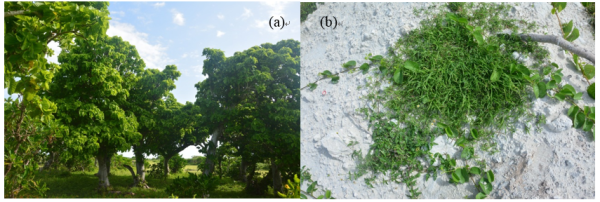

Vegetation is integral to coral reef as it facilitates accretion and stabilization, previous research proposed that vegetation was affected by habitat heterogeneity across a narrow, but clear environmental gradient. However, the restoration potential of vegetation and relationship to habitat is unclear.
Soil seed bank is the source of plant seedlings while microhabitats determine where plants are likely to occur on coral island. Thus, soil seed bank is critically important role to reflect vegetation restoration potential in restoration ecology. To advance scholarship in this area on tropical coral island, under the guidance of Prof. REN Hai, Dr. HUANG Yao from South China Botanical Garden of the Chinese Academy of Sciences initiated research on the influence of environmental factors on the variations in vegetation and soil seed bank diversity and community composition.
The researchers divided the whole island into three areas from the center to edge based on previous vegetation investigation. They used the data of more than 10 typical plant communities and their environmental factors along the environmental gradient.
The most unexpected finding was that, the climax community had the lowest species (less than 40%) similarity between vegetation and soil seed bank in the center area of island. The pioneer species communities had the highest species (more than 80%) similarity in the edge area, even though they were disturbed by tides.
The relationships between vegetation, soil seed bank and environmental factors changed with the habitat. Climax communities needed more soil nutrients while pioneer species were able to adapt to harsh habitat.
Why are restoration potential of the climax and pioneer species communities so different? In short, soil, climate, tide, diseases and insect pests, and community structure all play important roles in determining the pattern of vegetation and seed dispersal. Disentangling these causes will be an exciting area for future research.
Overall, this study explored the relationships between vegetation, soil seed bank and environmental factors and the pattern of vegetation and soil seed bank on a small coral island. The authors also indicate that the ecology stability and resilience of climax communities on coral island were weak and management and conservation practices might be needed.
For details, please refer to the paper, entitled “Relationships between vegetation and soil seed banks along a center to edge gradient on a tropical coral island”, recently published in Ecological Indicators (https://doi.org/10.1016/j.ecolind.2020.106689).

Figure. Pisonia grandis in center area (a) and herbaceous community in edge area (b) on East Island

